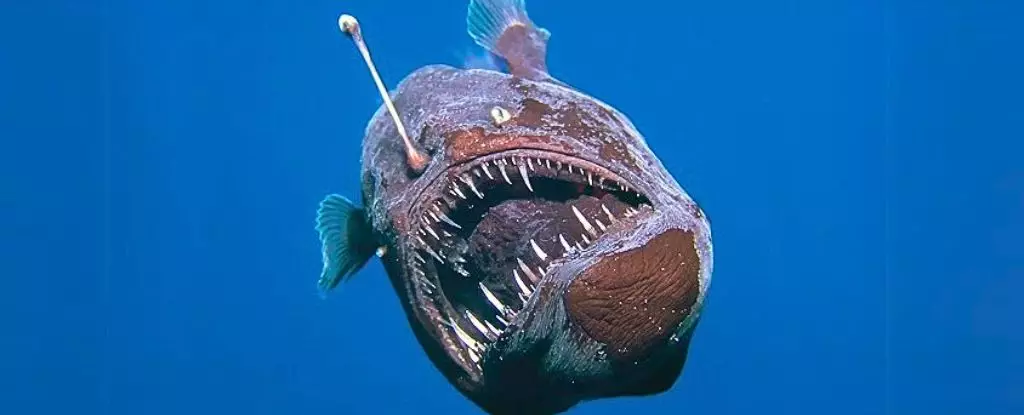The ocean, a vast expanse of mystery and wonder, continually unveils creatures that challenge our understanding of life on Earth. This was exemplified in February off the coast of Tenerife Island when researchers from the Condrik Tenerife organization stumbled upon a rare sight: a humpback anglerfish (Melanocetus johnsonii) swimming in daylight. Traditionally, these enigmatic creatures inhabit the dark, crushing depths of the ocean, known as the twilight zone, between 200 to 600 meters down. To witness one alive and in bright waters is nothing short of a biological marvel that should prompt serious reflection.
The encounter, captured poignantly by photographer David Jara Boguñá, transcends mere scientific curiosity. It’s a striking reminder of how little humanity truly comprehends the underwater realms. That a fish long perceived as a creature of nightmares and horror tales could emerge into the sunlight symbolizes not only the fragility of its existence but also the precarious state of our environment. Notably, anglerfish have been depicted in popular culture as grotesque monsters, invoking fear and fascination simultaneously.
Empathy Across Social Media
In the age of social media, the reactions to the anglerfish’s daylight appearance were overwhelmingly empathetic. Renowned platforms became flooded with comments, artworks, and animations that anthropomorphized the fish into something akin to a tragic figure, grappling with its fleeting mortality. Some described it as a feminist icon, representing strength and resilience, while others drew comparisons to Icarus, portraying the fish’s ascent to the surface as a literal pursuit of enlightenment and liberation. Such narratives underscore a burgeoning cultural shift, highlighting a growing empathy toward creatures deemed “ugly” or frightening.
The attention paid to the anglerfish reveals a curious human paradox: our struggle to embrace the beauty in the bizarre. It raises the question: why do we reserve such tenderness for certain creatures over others? The anglerfish’s former reputation as a monster contrasts sharply with the open admiration it garners today. Essentially, this unexpected attention is a potent commentary on our collective psyche, where aesthetics often dictate affection.
The Fish That Crossed Boundaries
What provoked the anglerfish’s appearance at such a seemingly shallow depth remains unclear. Theories span from environmental stressors to personal end-of-life journeys. This ambiguity reinforces the notion that not only do our oceans hide extraordinary life forms, but they also harbor complex stories that we may never fully comprehend. Researchers sift through evidence and speculation, asking whether humanity is responsible for compelling marine life from the safety of the deep.
The anglerfish serves as a metaphor for broader environmental issues, standing at the intersection of human curiosity and ecological responsibility. As technocentric societies, we often overlook the impact of our activity on marine ecosystems. Climate change, plastic pollution, and seabed mining are debilitating threats to these creatures, begging the notion of stewardship toward our planet.
Beyond Aesthetics: The Plea for Conservation
The newfound empathy toward the anglerfish and other bizarre species invites a much-need discussion about conservation. Stranger creatures have been neglected in conservation efforts, primarily due to their perceived “unlikability.” If the Icarus-like story of the anglerfish prompts educational dialogues about marine ecosystems, we might spark a much-needed revolution in how we approach environmentalism. Each new discovery should incite conversations regarding the interconnectedness of life forms and the necessity of safeguarding them against human recklessness.
While the anglerfish symbolizes environmental fragility, it also embodies hope—a potential model for how society can cultivate appreciation for all forms of life. The notion that these “monsters” can transition from symbols of fear to shrines of fascination is grounded in our collective willingness to open our minds and hearts. Empathy can become a catalyst for broader understanding and action.
The Role of Art and Culture
The viral response to this aquatic marvel compels us to recognize the power of art and storytelling in shaping perceptions of the natural world. The animated tributes and poetic reflections not only celebrate the anglerfish but also serve to fuse human experience with the natural environment, driving home the interconnectedness of our existence. If traditional representations of marine life foster consolidation of ecological ignorance, cultural reinterpretations like this can pave the way toward advocacy and activism.
In many respects, the anglerfish’s unexpected swim into the light serves as a call to revitalize awareness regarding our oceans. The legacy of Icarus should not end merely in myth; rather, it should challenge our own narratives about conservation and the legacies we leave behind. As we grapple with environmental decline, may stories like this instill a desire in us to protect those who, despite their strangeness, share our world and reflect its wonders.


Leave a Reply